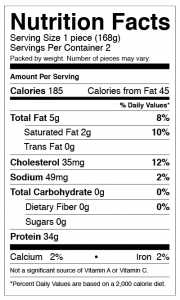It seems you just can’t win with fish these days. Dietary experts advise avoiding wild fish because they often contain high levels of mercury, nutritionists broadcast health fears linked to eating farmed fish, and environmentalists worry about which species are about to disappear off the planet.
But fish remains an excellent source of relatively fast-digesting whole-food protein, which means it’s time for some truth talk about fish fears.
Salmon (6 oz., raw): 248 calories, 37 g protein, 0 g carbs, 10 g fat, 0 g fiber.
When choosing between wild (Pacific) and farmed (Atlantic), go for wild. And don’t worry about the amount of fat in salmon – it’s all healthy polyunsaturated fat.
Eat salmon 2-3 times per week for its omega-3s, but not around workouts, as its fat content will slow protein digestion.
Tuna (packed in water, 6.5 oz.): 194 calories, 43 g protein, 0 g carbs, 1 g fat, 0 g fiber.
Salmon may be getting all the attention lately, but good old canned tuna actually has fewer calories, more protein and less fat.
And while salmon’s fats are all healthy, tuna is still the better choice for pre- or postworkout meal. Just be sure to pick your tuna wisely: Light tuna has less fat than white.
Swordfish (6 oz., raw): 206 calories, 34 g protein, 0 g carbs, 7 g fat, 0 g fiber.
The USDA advises certain populations (women of childbearing age and children, primarily) to avoid swordfish because it can contain high levels of mercury.
Provided you’re neither pregnant nor under 12, there’s no need to panic about your swordfish consumption if you have it just a few times a month.
Tilapia (6 oz., raw): 163 calories, 34 g protein, 0 g carbs, 3 g fat, 0 g fiber.
Tilapia is the fifth most popular seafood consumed in the U.S., according to the American Tilapia Association. No wonder: It’s low in fat and calories and has a decent amount of protein.
Since other low-fat fish such as snapper and orange roughy are overfished, tilapia is a great alternative.
Catfish (6 oz., raw): 230 calories, 26 g protein, 0 g crabs, 13 g fat, 0 g fiber.
Though catfish is extremely popular south of the Mason-Dixon line, most of the U.S. is sadly unaware of the potential of the freshwater fish.
Yes, it’s fatty, but its fats are primarily monounsaturated; they’re just not the same omega-3s that salmon has. So eat up – as long as it’s not deep-fried. [via]

